ecos
Hazard to Others
  
Posts: 464
Registered: 6-3-2014
Member Is Offline
Mood: Learning !
|
|
Oxidation of Ammoni
Hi All,
oxidation of ammonia to produce nitric acid happens on three steps:
4 NH3 (g) + 5 O2 (g) → 4 NO (g) + 6 H2O (g) (ΔH = −905.2 kJ)
2 NO (g) + O2 (g) → 2 NO2 (g) (ΔH = −114 kJ/mol)
3 NO2 (g) + H2O (l) → 2 HNO3 (aq) + NO (g) (ΔH = −117 kJ/mol)
This reaction happens in the presence of platinum or rhodium gauze catalyst at a high temperature of about 500 K and a pressure of 9 bar.
Platinum or noble metals are very expensive. Is there any other catalysts that can be used for Nitri acid synthesis ?
I found a patent that describe away to use ceramic catalyst with cobalt compound : http://www.google.de/patents/US5336656
the patent explain the process in example 4 but it was not very detailed and very hard.
I just plan to make nitric acid at home with Ostwald process. I am searching for a cheap catalyst. I don't care about its efficiency.
any ideas or suggestions ?
|
|
|
j_sum1
Administrator
       
Posts: 6218
Registered: 4-10-2014
Location: Unmoved
Member Is Offline
Mood: Organised
|
|
Short answer. Ostwald is not real friendly to the amateur home chemist. Now, you might be real innovative and come up with something new, but given
the range of things that have been tried over the decades, I doubt it.
I'm going to recommend you read the competition aga ran on making nitric acid. There wete many ideas discussed. As a total newbie at the time, I
learned a lot.
Home-cooked nitric acid and nitrates seems like one of those things that should be easy but it proves to be both awkward and elusive. Sulfur to
sulfuric acid is far easier than ammonia to nitric acid
|
|
|
Jstuyfzand
Hazard to Others
  
Posts: 166
Registered: 16-1-2016
Location: Netherlands
Member Is Offline
Mood: Learning, Sorta.
|
|
I gave up on ostwald, trying birkeland now.
If there is a catalyst I dont know about, I might resurrect my project...
|
|
|
PHILOU Zrealone
International Hazard
    
Posts: 2893
Registered: 20-5-2002
Location: Brussel
Member Is Offline
Mood: Bis-diazo-dinitro-hydroquinonic
|
|
Maybe use the biochemical way with nitrifying bacterias...
NH4(+) or urea --> NO2(-) --> NO3(-)
This occurs naturally into walls in contact with soils where you may find into the lower parts efflorescences of saltpeter (NaNO3 and KNO3)...
PH Z (PHILOU Zrealone)
"Physic is all what never works; Chemistry is all what stinks and explodes!"-"Life that deadly disease, sexually transmitted."(W.Allen)
|
|
|
ecos
Hazard to Others
  
Posts: 464
Registered: 6-3-2014
Member Is Offline
Mood: Learning !
|
|
I made search and found that cars has Catalytic Converters : https://www.youtube.com/watch?v=DZdHUZTdi68
this part is plated with Pt. 
Did anyone think to use this part as a catalyst to produce Nitric acid ?! I have some feeling that it will work.
@Jstufyzand, Birkeland–Eyde process has a yield of 4% and consume much power !
@PHILOU , I found a patent on google that use bacteria to make nitric acid. as far as i remember it take 10 days to get max 4000 mg/L of nitric acid
[Edited on 23-8-2016 by ecos]
|
|
|
Texium
|
Thread Moved
23-8-2016 at 08:10 |
PHILOU Zrealone
International Hazard
    
Posts: 2893
Registered: 20-5-2002
Location: Brussel
Member Is Offline
Mood: Bis-diazo-dinitro-hydroquinonic
|
|
Catalytic converters also convert NxOy exhaust gases into inoccuous N2(g) and O2(g).
PH Z (PHILOU Zrealone)
"Physic is all what never works; Chemistry is all what stinks and explodes!"-"Life that deadly disease, sexually transmitted."(W.Allen)
|
|
|
Jstuyfzand
Hazard to Others
  
Posts: 166
Registered: 16-1-2016
Location: Netherlands
Member Is Offline
Mood: Learning, Sorta.
|
|
That is if you pump NOx in, the trick is to not let the ammonia react too long, it might work.
As for birkeland, it might be inefficient but electricity is pretty cheap anyway, so it's doable I guess, whatever is more convenient.
|
|
|
PHILOU Zrealone
International Hazard
    
Posts: 2893
Registered: 20-5-2002
Location: Brussel
Member Is Offline
Mood: Bis-diazo-dinitro-hydroquinonic
|
|
A catalytic converter would also need a very good deep study of optimum T°, flow and reactant ratio (exept if you can only work with air then it is
N2/O2= 4/1)...a good deal of engineering techniques.
PH Z (PHILOU Zrealone)
"Physic is all what never works; Chemistry is all what stinks and explodes!"-"Life that deadly disease, sexually transmitted."(W.Allen)
|
|
|
ecos
Hazard to Others
  
Posts: 464
Registered: 6-3-2014
Member Is Offline
Mood: Learning !
|
|
Quote: Originally posted by PHILOU Zrealone  | | A catalytic converter would also need a very good deep study of optimum T°, flow and reactant ratio (exept if you can only work with air then it is
N2/O2= 4/1)...a good deal of engineering techniques. |
why you search for optimum values ? if you can get a yield of 40% is still a perfect thing.
|
|
|
PHILOU Zrealone
International Hazard
    
Posts: 2893
Registered: 20-5-2002
Location: Brussel
Member Is Offline
Mood: Bis-diazo-dinitro-hydroquinonic
|
|
Quote: Originally posted by ecos  | Quote: Originally posted by PHILOU Zrealone  | | A catalytic converter would also need a very good deep study of optimum T°, flow and reactant ratio (exept if you can only work with air then it is
N2/O2= 4/1)...a good deal of engineering techniques. |
why you search for optimum values ? if you can get a yield of 40% is still a perfect thing.
|
It is just the way a catalytic reactor works...too hot it won't work correctly and too cool it won't work at all.
Usually the working area of temperature can be as narrow as 50-100°C (sometimes best working into a 5-10°C range).
The main problem is that the catalyst may produce heat so you have to cool it down or it may consume heat so you have to heat it up...if wrong
temperature and flow control...then the reactor doesn't work long (maybe a minute) ... so even if your yield is 40% for 1 minute it is peanuts!
The second "problem" is that the flow of material may furnish heat if preheated or freshness if not preheated and it has to be taken into account.
So one working with this kind of reactors needs control loops (retro or feedforward loops) usually from T° probes at the input, into the catalyst, at
the exhaust and flow meter.
PH Z (PHILOU Zrealone)
"Physic is all what never works; Chemistry is all what stinks and explodes!"-"Life that deadly disease, sexually transmitted."(W.Allen)
|
|
|
ecos
Hazard to Others
  
Posts: 464
Registered: 6-3-2014
Member Is Offline
Mood: Learning !
|
|
Quote: Originally posted by PHILOU Zrealone  |
It is just the way a catalytic reactor works...too hot it won't work correctly and too cool it won't work at all.
Usually the working area of temperature can be as narrow as 50-100°C (sometimes best working into a 5-10°C range).
The main problem is that the catalyst may produce heat so you have to cool it down or it may consume heat so you have to heat it up...if wrong
temperature and flow control...then the reactor doesn't work long (maybe a minute) ... so even if your yield is 40% for 1 minute it is peanuts!
The second "problem" is that the flow of material may furnish heat if preheated or freshness if not preheated and it has to be taken into account.
So one working with this kind of reactors needs control loops (retro or feedforward loops) usually from T° probes at the input, into the catalyst, at
the exhaust and flow meter. |
Oh my god. I thought the temperature is just related to the catalyst material only!
do you know how this temperature is defined ?
Control loop means you need some sensors and control circuits to make sure everything has the right values !
[Edited on 24-8-2016 by ecos]
|
|
|
PHILOU Zrealone
International Hazard
    
Posts: 2893
Registered: 20-5-2002
Location: Brussel
Member Is Offline
Mood: Bis-diazo-dinitro-hydroquinonic
|
|
Quote: Originally posted by ecos  | Quote: Originally posted by PHILOU Zrealone  |
It is just the way a catalytic reactor works...too hot it won't work correctly and too cool it won't work at all.
Usually the working area of temperature can be as narrow as 50-100°C (sometimes best working into a 5-10°C range).
The main problem is that the catalyst may produce heat so you have to cool it down or it may consume heat so you have to heat it up...if wrong
temperature and flow control...then the reactor doesn't work long (maybe a minute) ... so even if your yield is 40% for 1 minute it is peanuts!
The second "problem" is that the flow of material may furnish heat if preheated or freshness if not preheated and it has to be taken into account.
So one working with this kind of reactors needs control loops (retro or feedforward loops) usually from T° probes at the input, into the catalyst, at
the exhaust and flow meter. |
Oh my god. I thought the temperature is just related to the catalyst material only!
do you know how this temperature is defined ?
Control loop means you need some sensors and control circuits to make sure everything has the right values !
[Edited on 24-8-2016 by ecos] |
    Welcome to the
real world! Welcome to the
real world!
"Do you know how this temperature is defined ?"
Like usual...by trial-error tests and optimisation of yield by slight modifications of the parameters 1 by 1 (simplex method or other methods).
PH Z (PHILOU Zrealone)
"Physic is all what never works; Chemistry is all what stinks and explodes!"-"Life that deadly disease, sexually transmitted."(W.Allen)
|
|
|
ecos
Hazard to Others
  
Posts: 464
Registered: 6-3-2014
Member Is Offline
Mood: Learning !
|
|
I could find a video that uses the Catalytic Converters of cars in oxidation of propane : https://www.youtube.com/watch?v=gSbf9OG29mQ
it seems the idea is valid. I beleive more now that it can be used to oxidize ammonia to get NO2.
|
|
|
ecos
Hazard to Others
  
Posts: 464
Registered: 6-3-2014
Member Is Offline
Mood: Learning !
|
|
I plan to buy a car's Catalytic Converters to verify if it can oxidize ammonia.
Any simple experiments to verify that?
[Edited on 1-9-2016 by ecos]
|
|
|
Chemetix
Hazard to Others
  
Posts: 375
Registered: 23-9-2016
Location: Oztrayleeyah
Member Is Offline
Mood: Wavering between lucidity and madness
|
|
That elusive nitric
I don't know why I would torture myself with giving this a go, but I did, and I'll explain the results of my findings. And it wasn't terrible.
The holy grail, per se, is to find a non PGM catalyst for Ostwald style nitric.
I wish to report that from an un-optimised study there is a catalyst that may fit the requirements of both activity and availability.
Cobalt carbonate on a silica fibre matrix at red heat seems to be a viable catalyst for NO production via NH3 air oxidation.
My initial study sought to control the copper catalysed oxidation of ammonia.
The apparatus:
Urea decomposition flask
50ml heating mantle
Condenser
Quartz reaction tube 10mm dia.
Electrolysis O2 generator
Copper scourer
Aquarium pump
flowmeter (from a gas chromatograph flow units unknown)
A propane/ air burner
Copper Carbonate (pottery grade)
Silica fibre
The experimental setup:
A heating mantle with a 50 ml flask was charged with about half it's volume of urea and 2ml of distilled water.
A quartz reaction tube designed to fit the ammonia generator and consist of an inlet venturi.
An oxygen source, ie. an aquarium air pump and an electrolytic source of O2.
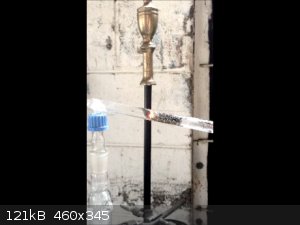
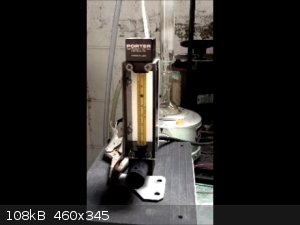
The Technique:
A flask with urea and an amount of water is heated via mantle to provide a stream of ammonia and CO2. A condenser is used to trap water vapour and
small amounts of ammonium carbamate. A source of oxygen from either air or pure oxygen was used. A flowmeter with unknown units of delivery was used
to control the amount of oxidiser delivered to the reactor.
A quartz tube with a venturi for air (oxygen) was set up on top of the ammonia generator, with a catalyst inserted far enough away from the inlet to
allow heating from an air propane torch, without damaging the
coupling to the ammonia generator.
Experiment 1
Copper metal catalyst/ air
The ammonia generator was started by heating the urea/water in the flask. The aquarium pump started and set to a low flow on the meter. Catalyst is a
piece of copper scourer and heating is applied to the catalyst region via a propane/air torch. At dull red heat the ammonia being generated should be
enough to show an exothermic reaction when in contact with the copper. There was no reaction with the copper using air, at any flow rate.
Experiment 2
Copper metal catalyst/ oxygen
The same arrangement was used except oxygen from the electrolysis cell was used.
At dull red heat the catalyst began to show incandescence at low flow rates of oxygen. There was no ability for the reaction to be maintained without
the application of heating.
At a high flow rate on the meter the reation became more pronounced even though it was pulsing regularly, the reaction was now self sustaining. Water
vapour was developing furthur down the reactor at a considerable rate.
Experiment 3
Cobalt carbonate /air
The same arrangement was used as experiment 1, except a catalyst of silica fibre soaked in a cobalt carbonate/water mixture then dried, was used.
Heating was applied at red heat and maintained, at no flow rate did the reaction show any exothermic reaction. At no point did the reaction become
self sustaining.
Results.
In experiments 1&2 the there was no brown NO2 developing from the end of the tube.
In experiment 3 there was no obvious NO2 but a distinct whiff of Nitric and then white fumes.
Conclusions:
The copper catalyst, although very active was too active, there was no evidence of any oxides of nitrogen, the quantity of water suggested there was
complete oxidation of the ammonia to nitrogen.
The cobalt carbonate required constant heating, but there was a waft of nitric vapours, until the ammonia generator started generating more ammonia
than the air flow can keep up, then white vapours began to appear at the end of the tube. Clearly there was nitric acid being formed in the
condensation water at the end of the tube and the excess ammonia began to fume with either ammonium nitrite or nitrate.
Discussion
Copper metal is a proficient catalyst for oxidation of ammonia in oxygen. Although air would probably work as well if the CO2 from the urea
decomposition reaction was removed. The reaction runs to completion with nitrogen and water seemingly the only products formed.
Cobalt carbonate shows activity as a catalyst, with evidence of nitric oxide/ nitrogen dioxide being formed. Controlling the rate at which ammonia is
formed is (not surprisingly) the limitation of how the reaction tube functions as a method of controlled oxididation of ammonia. A reservoir tank or
bladder with a pump, to collect, then deliver a constant ratio of ammonia to air into the reactor could create a viable means of benchtop Ostwald
style nitric acid.
[Edited on 9-11-2016 by Chemetix]
|
|
|
ecos
Hazard to Others
  
Posts: 464
Registered: 6-3-2014
Member Is Offline
Mood: Learning !
|
|
I am really surprised that copper works as a catalyst . I thought we need only Pt to oxidize ammonia.
i found a link that shows copper as a catalyst . it also has videos.
Link :
http://www.digipac.ca/chemical/mtom/contents/chapter3/fritzh...
http://www.digipac.ca/chemical/mtom/contents/chapter3/fritzh...
[Edited on 9-11-2016 by ecos]
[Edited on 9-11-2016 by ecos]
|
|
|
Chemetix
Hazard to Others
  
Posts: 375
Registered: 23-9-2016
Location: Oztrayleeyah
Member Is Offline
Mood: Wavering between lucidity and madness
|
|
Benchtop Nitric
Here is an updated and improved method of production of nitric acid via air oxidation of ammonia. Notably, the process relies on cobalt carbonate on a
sand matrix as a catalyst. Unfortunately I'm not able to spend the time on doing an awesome write up, but a quick and dirty explanation with some pics
should be enough for now.
The experimental setup:
Urea is charged to a 50ml flask and some water added, this is placed on a heating mantle as a source of NH3. A 1L flask with a 19/26 cone on the
bottom is fitted to the 50ml flask. The top of the one liter flask is fitted with a screw fitting,24/29 adapter. This adapter is modified to have a
gas outlet on the side. An 8mm piece of borosilicate tubing is inserted through the screw fitting and extends some way into the 1L flask. The NH3
filling the 1L flask is mixed with air from an aquarium pump which enters through the glass tube. The mixed gas leaves from the side spigot on the
modified adapter.
A quartz tube 250mm long, 10mm dia. is fitted with an inlet made of 3mm tube at one end, the other remains open but fitted with large screw thread
adapter. At a point closer to the inlet tube, the reactor is plugged loosely with glass wool. This is filled with enough catalyst to make a zone 3cm
long and then loosely plugged with glass wool. This zone sits roughly half way along the quartz tube.
A kanthal element is made from 0.6mm Kanthal wire wound onto a TIG welding filler rod 1.0mm dia. using a hand drill. The coil is then wound around the
catalyst zone and held in place with cellotape. Glass wool is packed between the coils and then the whole element is given a layer of Fibrofrax and
then a final layer of woven glass mat over the Firbrofrax. This is held in place with refractory string. The ends of the Kanthal element are joined
with a crimp to a thick copper wire and then connected with a terminal block to a variac.
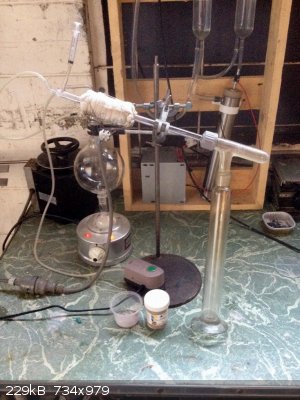
The catalyst is a 1:6 mixture of cobalt carbonate and builders sand.
No preparation other than add a spatulas worth and stir.
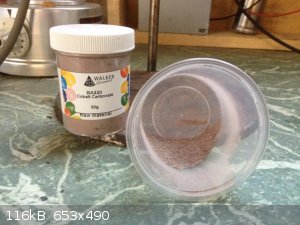
The method
The ammonia generator is started on a low setting and the aquarium pump turned on.
Ammonia from the generator is mixed with air in the 1L flask over the urea decomposition reaction. A larger mixing volume is needed to prevent the
slightly erratic generation of NH3 caused by concentrated solutions of NH3 returning to the flask. Pulses of NH3 would overwhelm the reaction zone and
allow ammonia to pass otherwise.
The catalyst heater is operated to provide red heat to the sand catalyst
About 23V AC and 2.0A was required.
The generator was slowly given more power until red fumed appear in the collection tube, a measuring cylinder was used in this instance. The cylinder
was loosely connected to the fitting to allow air to enter the cylinder and unreacted CO2 to escape.
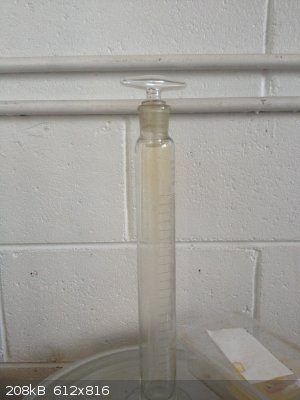
Results:
After running for about 10mins the red fumes had become quite concentrated. A spray of water was delivered into the cylinder and then returned to the
outlet of the reactor adapter. The red fumes dissolved in the water and collected on the bottom. The reactor was run for another 10 minutes and then
shut down. The picture was taken shortly after turning off all pieces of equipment. The liquid in the cylinder smelled distinctly of nitric and fizzed
when a small amount of sodium bicarbonate was added.
Discussion:
I do believe I have achieved benchtop nitric without platinum. I deliberately ran this apparatus without any cleanup of the raw materials and kept the
whole procedure as lean as possible with the required technology. Cobalt carbonate might need a constant source of heating and a large surface area to
be effective, and as such is not going to compete as an industrial catalyst. But it does seem to be effective at a small pilot plant level, capable of
generating molar amounts in a run.
Mods! - Should this post get a sticky in technochem? I think this is going to be of interest to a few of us
[Edited on 12-12-2016 by Chemetix]
|
|
|
symboom
International Hazard
    
Posts: 1143
Registered: 11-11-2010
Location: Wrongplanet
Member Is Offline
Mood: Doing science while it is still legal since 2010
|
|
Chemetix great post really shows the elusive nitric acid could be produced without high voltage or a nitrate salt on the small scale
[Edited on 12-12-2016 by symboom]
|
|
|
awlb2
Harmless

Posts: 27
Registered: 21-11-2016
Member Is Offline
Mood: No Mood
|
|
Platinum mesh, copper (II) oxide or chromium (III) oxide, when heated, can catalyse reaction between ammonia and oxygen from air to NO and then
further oxidation to NO2
|
|
|
Jstuyfzand
Hazard to Others
  
Posts: 166
Registered: 16-1-2016
Location: Netherlands
Member Is Offline
Mood: Learning, Sorta.
|
|
Quote: Originally posted by awlb2  | | copper (II) oxide, when heated, can catalyse reaction between ammonia and oxygen from air to NO and then further oxidation to NO2
|
Do you have any papers or patents on that?
I heard of it but I cant recall where, seeing a paper on it would provide some valuable insight also.
|
|
|
awlb2
Harmless

Posts: 27
Registered: 21-11-2016
Member Is Offline
Mood: No Mood
|
|
Ostwald Process
The oxidation of ammonia by those catalysts is often used as a demonstration:
http://www.rsc.org/Education/EiC/issues/2009May/ExhibitionCh...
This link shows info on using copper catalyst and further oxidation of NO to NO2 by air
Here's an old publication on it also:
http://pubs.acs.org/doi/abs/10.1021/ed011p575?journalCode=jc...
I might actually try the process in the above publication myself! 
It sounds like an interesting and easy way to make nitric acid but expensive platinum appears to be the most effective catalyst.  I presume this is why the Pakistani Government has not only banned
NH4NO3 but also urea and other non-oxidising ammonia salts to prevent manufacture of explosives! I presume this is why the Pakistani Government has not only banned
NH4NO3 but also urea and other non-oxidising ammonia salts to prevent manufacture of explosives!
[Edited on 12-12-2016 by awlb2]
|
|
|
Chemetix
Hazard to Others
  
Posts: 375
Registered: 23-9-2016
Location: Oztrayleeyah
Member Is Offline
Mood: Wavering between lucidity and madness
|
|
I know the old publications mention Pt and Cu as catalysts, but since Pt is expensive it's hard to get enough if it to make anything but a
demonstration quantity. A small change in colour with a pH indicator. Copper, in practice, oxidizes ammonia too much; it reverts to nitrogen and
water, see my experimentals in the post a little further back. The brass tube method from 1933 would need a lot of heating and still suffers from lack
of surface area to be useful.
The catalyst needs to be 1- available, 2- cheap, 3, effective.
A supported catalyst or a fluidised bed reactor, has the advantage of being easy to replace/maintain, so, using sand (silica grit) is a ghetto
solution to an industrial problem.
Cobalt carbonate was one of the trial oxides that had shown promise, and a scale up proved it is capable of generating useful amounts of nitric. The
next step is to see how long the catalyst can run and how low the temperature in the reaction zone can held and still run the reaction. There must be
some exothermic reaction, just slower than Pt or Cu and hence not the energy density appearing on the surface of the metals to be self sustaining.
If I was running a multi-tonne a day scheme I'd be concerned at the energy budget this catalyst needs. But it's a back yard/shed scale operation.
I hope to see some replications and optimisations from members.
I guess the next step is to couple this arrangement with a ghetto Haber plant.
[Edited on 12-12-2016 by Chemetix]
|
|
|
awlb2
Harmless

Posts: 27
Registered: 21-11-2016
Member Is Offline
Mood: No Mood
|
|
Thanks, and best of luck with developing the process. I will probably give it a try with both platinum and cobalt carbonate catalysts and see how they
compare some day. Attempting the Haber process on a small scale could be interesting, as well.
|
|
|
Chemetix
Hazard to Others
  
Posts: 375
Registered: 23-9-2016
Location: Oztrayleeyah
Member Is Offline
Mood: Wavering between lucidity and madness
|
|
I think there needs to be something mentioned about the dangers of NO2. I have always treated NO2 as an environmental pollutant, something that gives
people with asthma a little more irritation than they need, or contributing to acid rain. But it's A DEADLY POISON! While given a demonstration of
dissolving copper in nitric as a high schooler I was advised you don't want to breath the red fumes, and that was about all I had been given about
its' toxicity. Avoid it.
Out of interest I looked up more about its' toxicity while the reactor was running. 200ppm fatal. Or so said the Merke index. Insidious poison it
said. Holy SHITE!
This stuff creeps up on you and destroys your lungs, you can die five hours later from exposure with very little symptoms. Cumulative LD50 around
60ppm for 8 hrs. This stuff is like phosgene, except no real smell and little to tell you it's around. I feel a little embarrassed that I made a piece
of equipment that can churn out lethal quantities of gas without having done some more homework. My complacency stems from having RFNA around or
working with glass flasks on the glass lathe. The oxy-LPG flame is hot enough to fill the flask as you join it, with red tinged fumes. And I get the
odd exposure from the blow tube without ill effects (or so I thought).
But MSDS values are highly conservative usually, you might, in practice never get the exposures to do you damage, but I'm not going to risk that. I'm
going to seriously improve the work area and be a little less cavalier. Mandatory safety message transmitted!
If you do want to generate NO2 using this technique, ventilation and safety management!
|
|
|